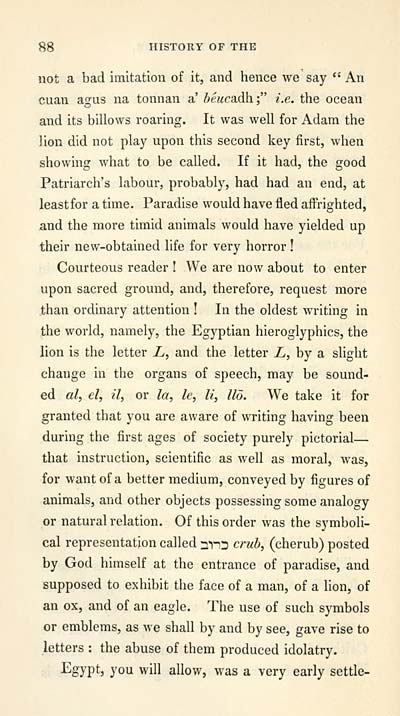Download files
Complete book:
Individual page:
Thumbnail gallery: Grid view | List view

%S HISTORY OF THE
not a bad imitation of it, and hence we say " An
cuan agus na tonnan a' beucsidh.f i.e. the ocean
and its billows roaring. It was well for Adam the
lion did not play upon this second key first, when
showing what to be called. If it had, the good
Patriarch's labour, probably, had had an end, at
leastfor a time. Paradise would have fled affrighted,
and the more timid animals would have yielded up
their new-obtained life for very horror !
Courteous reader ! We are now about to enter
upon sacred ground, and, therefore, request more
than ordinary attention ! In the oldest writing in
the world, namely, the Egyptian hieroglyphics, the
lion is the letter L, and the letter L, by a slight
change in the organs of speech, may be sound-
ed al, el, il, or la, le, li, lid. We take it for
granted that you are aware of writing having been
during the first ages of society purely pictorial —
that instruction, scientific as well as moral, was,
for want of a better medium, conveyed by figures of
animals, and other objects possessing some analogy
or natural relation. Of this order was the symboli-
cal representation called ninD crub, (cherub) posted
by God himself at the entrance of paradise, and
supposed to exhibit the face of a man, of a lion, of
an ox, and of an eagle. The use of such symbols
or emblems, as we shall by and by see, gave rise to
letters : the abuse of them produced idolatry.
Egypt, you will allow, was a very early settle-
not a bad imitation of it, and hence we say " An
cuan agus na tonnan a' beucsidh.f i.e. the ocean
and its billows roaring. It was well for Adam the
lion did not play upon this second key first, when
showing what to be called. If it had, the good
Patriarch's labour, probably, had had an end, at
leastfor a time. Paradise would have fled affrighted,
and the more timid animals would have yielded up
their new-obtained life for very horror !
Courteous reader ! We are now about to enter
upon sacred ground, and, therefore, request more
than ordinary attention ! In the oldest writing in
the world, namely, the Egyptian hieroglyphics, the
lion is the letter L, and the letter L, by a slight
change in the organs of speech, may be sound-
ed al, el, il, or la, le, li, lid. We take it for
granted that you are aware of writing having been
during the first ages of society purely pictorial —
that instruction, scientific as well as moral, was,
for want of a better medium, conveyed by figures of
animals, and other objects possessing some analogy
or natural relation. Of this order was the symboli-
cal representation called ninD crub, (cherub) posted
by God himself at the entrance of paradise, and
supposed to exhibit the face of a man, of a lion, of
an ox, and of an eagle. The use of such symbols
or emblems, as we shall by and by see, gave rise to
letters : the abuse of them produced idolatry.
Egypt, you will allow, was a very early settle-
Set display mode to: Large image | Transcription
Images and transcriptions on this page, including medium image downloads, may be used under the Creative Commons Attribution 4.0 International Licence unless otherwise stated. ![]()
| Early Gaelic Book Collections > Blair Collection > History of the Celtic language > (94) |
|---|
| Permanent URL | https://digital.nls.uk/76179643 |
|---|
| Description | A selection of books from a collection of more than 500 titles, mostly on religious and literary topics. Also includes some material dealing with other Celtic languages and societies. Collection created towards the end of the 19th century by Lady Evelyn Stewart Murray. |
|---|
| Description | Selected items from five 'Special and Named Printed Collections'. Includes books in Gaelic and other Celtic languages, works about the Gaels, their languages, literature, culture and history. |
|---|

